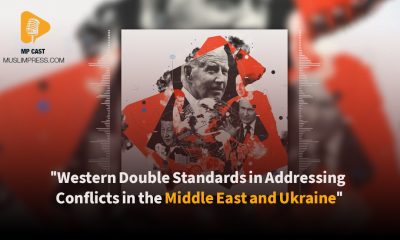World news
“Cultural Theory of Revolutions” , the manifestation of the soft power of the Iranian Islamic Revolution
The victory of the Islamic Revolution in Iran under the leadership of Imam Khomeini in the late 20th century disrupted all the international equations defined within the framework of the bipolar system of the East and West. This revolution, which differed significantly from the theoretical framework of what was considered necessary for a revolution, emerged at a time when human society was moving towards sidelining religion from the political and social aspects of life. The Islamic Revolution of Iran had visible and distinct effects on governments, movements, and popular groups in Islamic countries, especially among Shiite communities, reviving Islam and Islamic societies, and breaking them free from stagnation and seclusion. The released energy subsequently became the driving force behind all Islamic uprisings, movements, and activities in the Muslim world. Based on its identity components, such as returning to one’s self, supporting the oppressed, combating Zionism, religious democracy, justice-seeking, self-reliance, supporting freedom movements, Islamic resistance, the concept of the Awaited Imam, and anticipation, the Islamic Revolution played a crucial role in reviving Shiite Muslims who had been marginalized in Arab countries. In particular, the Shiite population in Yemen came under the influence of Islamic-Shiite thought, which marked the beginning of the Ansarullah movement or the Houthi Shiite movement. In the early days of the Islamic Revolution, many Yemeni figures, such as Badr al-Din and Hussein al-Houthi, looked up to Imam Khomeini’s thoughts as a model for establishing the Islamic resistance front in Yemen. During this period, many Yemeni clerics also entered the religious seminaries in Qom to become more acquainted with the ideas of the revolution.
The soft power of the Islamic Revolution, the grounds for the growth and maturation of the axis of Islamic resistance in the West of Asia, is considered a significant concept in international relations, and it is inherently debatable because there is no inherent and essential relationship between the components of power. The concept of power seeks its manifestations in synonymous discourses. The emergence of non-state actors, mutual economic interdependence, advanced technologies, and the development of smart communication networks indicate a new era in global politics. In such a situation, the capability focused on being up-to-date, as a central pillar of power in pragmatic schools of thought, has been subjected to serious criticism, and a modern interpretation of the concept and application of power has emerged, so much so that soft power has gained special attention. In this kind of power, which is soft power, a wide range of diverse, attractive, yet sensitive aspects is presented to the leaders of a country through attraction and avoidance, without resorting to coercion. Joseph Nye introduces soft power as “the ability to shape the preferences of others through appeal based on culture, values, and foreign policy.”
In another definition, soft power refers to those capabilities and resources of a country, such as culture, ideals, or moral values, that indirectly influence the resources or behaviors of other countries. One of the most comprehensive definitions of soft power is attributed to the theorist of this term, Joseph Nye, an American scholar: “The ability to shape the desires of others through attraction based on culture, values, and foreign policy”.
The Islamic Revolution in Iran served as a new and distinct identity at a time when it had unique features and components. What distinguishes the Iranian Revolution from other revolutions is its cultural dimension and its software aspects. While during other revolutions of the same era, the world was mainly focused on the material dimensions of revolutions, such as liberation from tyranny, gaining freedom, securing livelihood, and housing, the occurrence of such a revolution with a religious and divine foundation that had the power of mass mobilization for everyone and was based on spiritual and non-material power to achieve victory was a different story.As Michel Foucault, a contemporary French philosopher, also emphasizes in his analysis of the Iranian Revolution, the revolution in Iran was software-oriented in comparison to the Shah’s hardware-based power. He points out that what has amazed him in Iran is that there is no struggle between different elements. What gives them all significance is that there is only one dream: a dream among all the people and a power that threatens the people with weapons and police. On the one hand, the will of the people, and on the other hand, the masses are in place.
In fact, the Islamic Revolution in Iran gave rise to an important theory in the general theories of revolutions under the title of the “Cultural Theory of Revolutions,” which is, in reality, the manifestation of the soft power of the Iranian Revolution that has its roots in Islamic and religious beliefs. The most important components of soft power and identity-building in the Iranian Islamic Revolution for its export to Muslim countries, especially Shiites, include:
– Institutionalization, Islamic identity, and political ideology.
– Rejection of tyranny.
– Justice-seeking and opposition to oppression.
– Spirituality in politics.
– Anti-dictator and anti-Islamic regimes.
– Martyrdom culture.
– Creating collective will, populism, and non-violence.
– Return to self.
– Religious government (spirituality in politics).
– Support for the oppressed and freedom movements.
– Independence-seeking (neither Eastern nor Western).
– Islamic resistance.
– Confrontation with Zionism.
– Belief in the Mahdi and the Awaited One.
In this regard, one of the significant and influential achievements of the components of soft power of the Islamic Revolution of Iran has been the formation of the Axis of Islamic Resistance in the West of Asia. Regarding resistance, it should be noted that resistance is produced from power and generally in the relationship between resistance and power, it gives the weight of superiority to power. In fact, the degree and manner of resistance are highly determinative in the confrontation between power and resistance, as resistance is inherently equipped with the minimum tools against power, except that resistance also uses ideological tools. When resistance uses ideology, it gains a multiplier capability, creates a strong popular support base, and benefits from non-physical tools as well.
Resistance, as a liberating concept within the paradigm of challenging power and based on the narrative of the Islamic Revolution, is derived from pure Islamic principles and the international system. Such resistance is dynamic and rooted in the Islamic Revolution, not passive resistance drawn from Quranic texts and the traditions of the Prophet. Therefore, the most significant consequence of the Islamic Revolution can be seen as a challenge to the hegemony and domination of the Western world over surrounding regions.
The Axis of Resistance is a political term first introduced by the Libyan newspaper “Al-Zahf Al-Akhḍar” as a response to the term “Axis of Evil” coined by George W. Bush in 2002. The countries referred to as the Axis of Evil by the US President were, in fact, considered countries resisting US hegemony and its attempts to dominate other nations. The Axis of Resistance is a geopolitical coalition comprising both state actors (Iran, Syria, and Iraq) and non-state actors (Hezbollah, Hamas, Islamic Jihad, and Yemen’s Houthi movement). They share common national and ideological interests, with Iran playing a central role.
This axis emerged in opposition to the coalition of conservative Arab countries led by Saudi Arabia in the region. As the Axis of Resistance strengthened, it faced increased opposition and efforts to promote and support Salafi and Wahhabi groups. In a discourse analysis of the Resistance narrative, two main categories can be identified: negative and affirmative. The negative aspect revolves around resistance to hegemony, while the affirmative dimension encompasses justice-seeking, Islamism, peace advocacy, dignity, independence, freedom, spirituality, wisdom, pragmatism, and idealism.
The embodiment of resistance is the Palestinian people, who chose to stand up against the Israeli regime instead of engaging in negotiations, marking the essence of the Palestinian resistance. The impact of the Islamic Revolution on Palestine is unparalleled, as the Muslims in Palestine were more desperate and oppressed than any other Muslim population while living under Israeli occupation. The formation of the Palestinian resistance, rooted in the aspiration of the oppressed people of Palestine, serves as a model for confronting oppressors and striving for the rights of the oppressed.

You may like
-


Iran’s Anti-Hegemony Stance Strengthens, Cementing Its Role as Region’s Most Independent Nation
-


Israel will collapse when God fulfills Iranian nation’s ‘Death to America’ prayer: Albanian historian
-


“Western Double Standards in Addressing Conflicts in the Middle East and Ukraine”
-


“Harris-Trump Debate Sparks New Controversies in U.S. Political Landscape”
-


“Netanyahu’s Strategy Crumbles as Hezbollah Expands Battlefield: Refugee Crisis Worsens”
-


The inspiration of Iran’s Islamic revolution on Yemen’s Islamic resistance movements


Iran’s Anti-Hegemony Stance Strengthens, Cementing Its Role as Region’s Most Independent Nation

Israel will collapse when God fulfills Iranian nation’s ‘Death to America’ prayer: Albanian historian

Bloodshed in the Shadows: West Bank Crisis Deepens as Gaza Dominates Headlines

An anti-Semite is now someone Jews don’t like

Negotiations a way for coercive govts. to impose new demands that definitely won’t be fulfilled

Bloodshed in the Shadows: West Bank Crisis Deepens as Gaza Dominates Headlines

Israel will collapse when God fulfills Iranian nation’s ‘Death to America’ prayer: Albanian historian

Iran’s Anti-Hegemony Stance Strengthens, Cementing Its Role as Region’s Most Independent Nation

Jewish parties foreign policy

Will Israel adhere to its commitments under the ceasefire agreement?

“Western Double Standards in Addressing Conflicts in the Middle East and Ukraine”

“Harris-Trump Debate Sparks New Controversies in U.S. Political Landscape”

Challenges Facing the U.S. Navy: Addressing Gaps in Strategy and Capability

